The 10th place were we decided to fish was a very beautiful small river, from
the population living there called "Sungai Semandai".
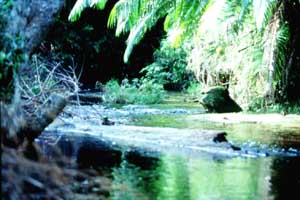
Biotope 10, Sungai Semandai, a
small forest stream © 2001 Michael Schlüter
Already from the bank of the
river we could recognize Hemirhamphodon. These got caught in the best with a push net with
handle. Therefore the net was led slowly from below to the fish. These were actually
Hemirhamphodon kapuasensis! Our joy at this species expressed itself after two hours in
the number of caught specimen. We did catch nearly 50 of these kind. Only then we tried,
also from the bigger barbs which stood in the deeper areas of the river to catch at least
one sample. On account of the wood storages and a lot of stones catching the fishes with
the dip net was not possible. With the push nets we had almost no chance. We could catch
only a smaller specimen of this kind, Osteochilus hasselti. The clear, brown water had at
4.30 o'clock p.m. a temperature of 27,5 °C, with a pH factor of 5,3 and 8 µS/ccm ³. The
other search, particularly in the bank area proved the following species: Rasbora agilis,
Betta cf. anabatoides, Nandus nebulosus and an Rasbora cf.
ennealepis. They had a grey-metallic body colour with a copper-coloured lateral line. The
back, anus and tail fin gleamed red-brown. Particularly saliently was here a silver white
shiny line which began in the back shortly behind the dorsal fin and reached up to tail
root. The back and tail fin basis were in the edges white coloured. The pelvic fins were
striped white narrow. The biggest fish of this species caught by us had in length of 45
mms. In the aquarium they turned out fast swimmers who hunt themselves frequently.
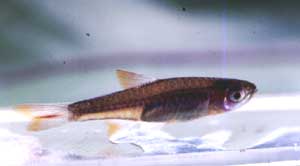 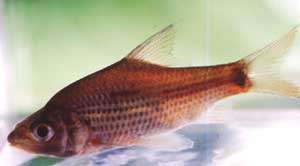
Rasbora cf. ennealepis © 2001 Michael Schlüter
Cyclocheilichthys apogon © 2001 Michael Schlüter
After we had packed some of the Hemirhamphodon and the before named Cyprinids, next day we
went back to Pontianak. We also wanted to see how the fishes we left behind were looking.
On the way back our eleventh biotope had similar water values (11.00 o'clock a.m.,
temperature 27 °C, pH factor 5,6, conductivity 5 µS/ccm ³) and was beautiful as our
last river the day before. The people here named the river “Sungei
Merah”.
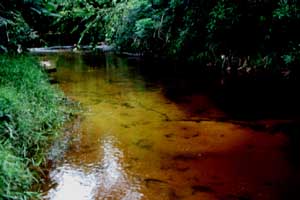
Biotope 11, Sungai Merah, the
Red River © 2001 Michael Schlüter
Here we caught Luciocephalus pulcher, Channa ssp., Hemirhamphodon kapuasensis, Nandus
nebulosus, Pristolepsis spec. and two Rasbora-sorts. The high number of predators in
comparison to the peaceable fishes did surprised us. Fishing site number 12 was a ditch
with brown, nearly not moving water which was bounded by a net. The water temperature
amounted at 2.00 o'clock p.m. 29 °C, pH factor 5,95, 16 µS/ccm ³.
We could catch Betta edithae, Parosphromenus anjuganensis, Trichogaster trichopterus,
Cyclocheilichthys apogon, Osteochilus hasselti, Rasbora sp. aff. sumatrana, R.
pauciperforata, here with yellow longitudinal strips, R. bankanensis, Mystus spec. and
Pristolepsis spec. After arrival in our pension the fish we left behind looked well. We
stated the first losses with the discharge of the reservoirs and plastic bags. The
Hemirhamphodon kapuasensis from the tenth biotope all died. The water has probably got hot
in the plastic bag too strongly. Of course it always happened to the most beautiful fish.
Our intension to travel was interrupted by two burst tyres and after return in
Pontianak by a hole in the cooler of the
Toyota Kijang. Next day we wanted to get again black water from the first biotope for the
water change. Certainly, was said that next day the vehicle is repaired, however, on the
trip we had to turn round shortly before our first fishing site. The cooler had run dry in
the last four kilometres five times. For a longer journey an unfavourable starting
position. Unfortunately, the repair lasted so long that we rented a substitute vehicle.
The organization of the substitute vehicle needed so much time, that
we had to give up our
plans to go to Ketapang by ferry.
So we decided at the 08.10.01 to go northeast
to Toho on direction of Sungei Penjuh. Here there should be according to information of a
friend of our guide called Ipong, who had searched for a new vehicle with us, some small
black water rivers. Our thirteenth fishing site lay in a savannah and was a 10 to 15
meters wide, at some places only four meters wide black water river. In the middle it was
something about two meters deep. Therefore we could use the dip net only in the bank area.
The coffee-coloured water flowed moderately to strongly about sandy and muddy subsoil. In
the water was little foliage. In the bank area stood a lot of bulrushes, frequently with
algae puts between. The water temperature amounted at 2.00 o'clock p.m. 28 °C, pH factor
4,34 with 24 µS/ccm ³. Many of the species we caught were the same like the fishes of
our first fishing site. We could catch Puntius hexazona, Osteochilus spilurus, Rasbora
agilis, R. pauciperforata, Sundadanio axelrodi green, Neohomaloptera johorensis,
Kottelatlimia cf. pristes, Belontia hasselti, Betta edithae, Mastacembelus spec. and an
unknown goby, maybe a Pseudogobius. Unfortunately, the gobys were very void, so that we
took only one fish in order to take a picture. The Sundadanio, as well as the
Neohomaloptera and the Kottelatlimia did not have the beautiful colouring like the fishes
from the first biotope. Maybe because of the water pollution from the wood cutting here in
bigger quantities?
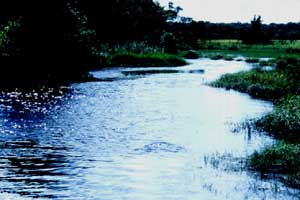
Biotope 13, a Blackwater River
© 2001 Michael Schlüter
The next fishing site was a 100
to 150 cm wide and between 20 and 80 cm deep small clearwater river in the wooded hill
country. At 3.00 o'clock p.m. we could measure the water temperature with 29 °C, pH
factor 7,12 and 36 24 µS/ccm ³. There we have caught only three different species:
Rasbora cephalotaenia, Lepidocephalichthys spec. and Hemirhamphodon phaiosoma.
Next day we found our Hemirhamphodon kapuasensis laying in the linen dish with the belly
upwards. Some foam was to be seen in the surface. We have ventilated the reservoirs,
however, the foam we saw could not come of it. Some soap had probably fallen in the
reservoir. In spite of repeated water change the half of the Hemirhamphodon died up to the
next evening.
So we decided on 10/10/01 one more time to go to our eleventh fishing site and to catch
again Hemirhamphodon kapuasensis. Luckily, we had Ipong for driving. He made the trip in
3,5 hours. After we found again the place we did catch 15 halfbeaks between 3 and 6 cm of
length within 40 minutes. Than we decided to visit a river named Sungei Tekam, were
Roberts (1989) already fished in 1976. We wanted to look for Eirmotus octozona, a small
nice barb. The small river flowed directly according to local residents into the Sungei
Merah. Here there should also be Sphaerichthys vaillanti. Unfortunately, we could not
catch this species in spite of intense efforts. But we did catch the Eirmotus octozona
with our second fishing. Furthermore we caught Hemirhamphodon kapuasensis and H.
phaiosoma, Rasbora agilis, Betta cf. dimidiata, Nandus nebulosus, a Channa species and a
young goby. The pH factor with 5,59 and the temperature with 27 ° C at 3.00 o'clock p.m.
deviated from Roberts (1989) measurements. The conductance amounted to 5 24 µS/ccm ³.
However, Roberts had fished farther at the top in the course of this river. The clear,
fast floating small river was surrounded of properties in the mouth area which go over
after already 500 meters in secondary rain forest. The average with amounted to
approximately 1,5 meters with a depth of 60 cm. In some areas it was 30 cm deep, in others
up to 90 cm. Behind the last house we could find many aquatic plants like nice
Cryptocoryne and Cabomba. The ground level consisted of fine sand with a lot of foliage
storages. If it had not started to rain suddenly and very strong, we would still have
remained up to the evening.
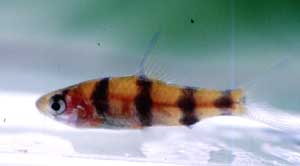 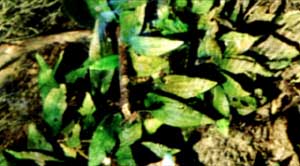
Puntius hexazona © 2001 Michael Schlüter
Cryptocoryne spp. Biotope
15, Sungai Tekam © 2001 Michael Schlüter
Back in Pontianak we decided to
go a day later again to our first fishing site to catch there Sundadanio axelrodi,
Parosphromenus and Betta rutilans for our aquariums. During the fishing our guide was
phoned by a friend who reported that "sweepings" was announced by the news in
the radio. Kasigen told us to finish our activities and go back to the hotel immediately.
There we did not get any
informations. In the next
morning it was said to us by the hotel administration that we should leave the hotel
within one our on account of the announced "Sweepings". The already caught fish
remained there because we decided Kasigen could rent the room on his name. After a night
in a private accommodation at Ipongs house we decided to pack the fish and to depart
because in the hotel they did not wanted let us back in the room and nobody really knows
anything.
This was the only
bad part of our trip, except from the raining witch makes it impossible to catch in the
bigger rivers. Nearly anybody we did met was friendly and helpful, independent of their
religion.
Up to Eirmotus octozona all fish has well gotten over the
long way back, so we were really happy when we did arrive back to Germany including a lot
of very nice fish.
If anybody want to have coordinates please send a mail.
I would like to thank Erik Witte of the University of Tübingen, Germany for the temporary
identification of the species. He call it "quick and dirty”.
Literature
|
